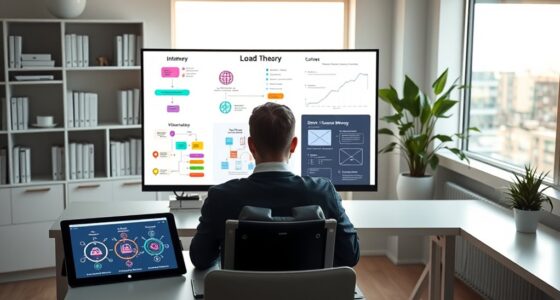To manage your screen time for better mental health, start with small steps like setting time limits and turning off non-essential notifications. Gradually reduce your social media and device use while replacing those moments with outdoor activities or hobbies. Focus on establishing realistic habits that fit your lifestyle, and remember that intentional disconnection can boost your focus, reduce stress, and improve emotional resilience. To learn practical strategies and how different approaches work, keep exploring this topic further.
Key Takeaways
- Reducing screen time lowers depressive symptoms and stress, improving overall emotional well-being and mental clarity.
- Setting specific goals and gradually limiting social media and device use helps manage digital dependency effectively.
- Incorporating outdoor activities and natural breaks enhances mental health benefits during digital detox periods.
- Turning off non-essential notifications and scheduling device-free times reduces distractions and cognitive overload.
- Personalizing detox strategies boosts motivation, leading to sustained healthier digital habits and improved emotional resilience.
Understanding the Mental Health Benefits of Digital Detox

Have you ever wondered how taking a break from screens can boost your mental health? Digital detoxes can considerably reduce depressive symptoms by cutting back on social media and smartphone use. You might notice improved emotional regulation, less stress, and a greater sense of well-being. For those with higher baseline depression, even short detox periods can bring notable relief. Digital detoxes also support mindfulness and help you focus on purposeful activities, fostering personal growth. Strategic, gradual disconnection is more effective than complete abstinence, making the process sustainable. By intentionally managing your screen time, you create space for reflection, real-world interactions, and emotional balance, which all contribute to better mental health and a more fulfilling life. Incorporating digital detox reviews and guides can help you identify effective strategies tailored to your needs.
Recognizing Screen Time Trends and Overload in 2025

In 2025, you’re likely spending over 10 hours a day on digital devices, blending work, leisure, and dependency. Constant notifications from multiple screens increase your cognitive fatigue and stress levels. Younger generations, especially Gen Z and millennials, show higher digital reliance, making overload a widespread concern. To mitigate these effects, many are turning to essential oils like lavender and peppermint, which can help promote relaxation and reduce stress caused by screen overload.
Rising Digital Engagement Levels
By 2025, digital engagement has reached unprecedented levels, with the average adult spending over 10 hours daily on screens that blend work, entertainment, and social interaction. This constant connectivity means you’re almost always online, juggling multiple platforms and notifications. Your devices seamlessly integrate into every aspect of life, making it easy to stay plugged in. As a result, you may notice increased cognitive load, stress, and difficulty disconnecting. Younger generations, especially Gen Z and millennials, are particularly affected, often checking social media within minutes of waking and spending hours browsing. This relentless digital presence contributes to feelings of overload and fatigue. Recognizing these trends is essential for understanding how overuse impacts mental health and highlights the need for intentional digital boundaries. Additionally, the rise of AI-driven security systems ensures that while we stay connected, our data remains protected amidst increasing digital engagement.
Notifications and Cognitive Fatigue
Are constant notifications from your devices contributing to your cognitive fatigue? In 2025, frequent alerts can overwhelm your brain, making it harder to focus and process information efficiently. You might not realize how much these interruptions drain your mental energy. Consider these points:
- Increased Distraction: Multiple notifications break your concentration, forcing your brain to switch tasks repeatedly.
- Stress Accumulation: Continuous alerts activate stress responses, heightening anxiety and emotional fatigue.
- Reduced Productivity: Constant interruptions decrease your ability to complete deep work, prolonging mental exhaustion.
- Optimizing Your Digital Environment: Adjusting your device settings and utilizing sound recording techniques can help minimize unnecessary alerts and improve focus.
These overloads make it difficult to maintain mental clarity. Recognizing how notifications impact your cognitive health is vital for managing screen time and reducing fatigue. Turning off non-essential alerts can help regain focus and mental resilience.
Youth Digital Dependency
Have you noticed how young people are spending more hours glued to their screens than ever before? In 2025, youth digital dependency reaches new heights, with many spending over four hours daily on social media, gaming, and streaming. Gen Z and millennials are especially affected, often checking their devices within minutes of waking up. This constant connectivity blurs boundaries between work, leisure, and social life, increasing stress and cognitive overload. Many teens feel unable to disconnect, fueling a cycle of dependency. The pressure to stay updated and connected is intense, making digital detox challenging. Recognizing these trends helps you understand the importance of setting boundaries and practicing mindful digital habits to support mental health and reduce overload. Vetted – Grobal World
Common Challenges and Behavior Patterns in Digital Detox Efforts

Many people attempting digital detox face persistent challenges that hinder their progress. You might find yourself slipping back into old habits despite your intentions. Common patterns include:
- Cravings for social media or gaming, making it hard to resist opening apps or screens.
- Feelings of boredom or anxiety, prompting you to seek digital distraction as a quick fix.
- FOMO (fear of missing out), which fuels the urge to stay connected and check notifications constantly.
These behaviors often stem from emotional dependence on digital devices or the habit of immediate gratification. Overcoming them requires awareness of triggers, patience, and consistent effort. Recognizing these patterns helps you develop strategies to manage cravings and build healthier routines. For example, understanding the role of instant gratification in digital habits can motivate you to find alternative activities that provide fulfillment without screens.
Effective Strategies for a Successful Digital Detox

To succeed in your digital detox, start with a gradual reduction of screen time rather than quitting cold turkey. Creating a personalized plan that fits your habits makes it easier to stick with the detox and see lasting benefits. Adjusting strategies to your specific needs helps you regain control and improve your mental well-being. Incorporating mindfulness practices during your detox can further enhance your emotional resilience and overall mental health.
Gradual Tech Reduction
Implementing a gradual reduction in your tech use is often more effective than trying to cut everything off at once. You’ll find it easier to break habits and stay committed when easing into change. Start by identifying your most time-consuming apps or devices. Then, follow these steps:
- Set specific time limits for daily use of social media or gaming, gradually decreasing each week.
- Schedule tech-free periods during your day, like mornings or before bed, and extend them gradually.
- Replace screen time with alternative activities, such as reading, exercise, or hobbies, to make the transition smoother.
- Incorporate efficient energy use practices, like reducing unnecessary device operation, to support your overall efforts in managing screen time and maintaining mental well-being.
This approach minimizes withdrawal and stress, helping you develop healthier, sustainable habits that support your mental well-being.
Personalized Detox Plans
Creating a personalized detox plan increases your chances of success by addressing your unique digital habits and needs. First, identify your main digital stressors and usage patterns. Then, set realistic, specific goals tailored to your lifestyle. Use the table below to customize your approach:
| Habit/Device | Action Step | Timeframe |
|---|---|---|
| Social media | Limit sessions to 15 minutes/day | 1 week |
| Smartphone notifications | Turn off non-essential alerts | Immediate |
| Gaming | Schedule gaming only on weekends | 2 weeks |
| Work emails | Check only during designated hours | Daily, with breaks |
Adjust these components as you progress. Personalization helps you stay motivated and effectively reset your digital habits for better mental health. Incorporating wave and wind considerations can also enhance your overall detox strategy by promoting natural breaks from screens and encouraging outdoor activities.
Psychological and Cognitive Improvements From Digital Breaks

Taking a break from digital devices can lead to significant improvements in your psychological and cognitive well-being. When you disconnect, your focus sharpens, making it easier to concentrate on tasks without constant interruptions. You’ll notice reduced stress levels, as digital overload often fuels anxiety. Additionally, stepping away allows you to strengthen real-world relationships and reflect more deeply on your thoughts and feelings. Engaging in activities like playing arcade games or exploring new hobbies can further enhance your mental clarity and emotional resilience.
Attitudes and Demographics Shaping Digital Detox Practices

Attitudes toward digital detox vary considerably across different demographics, shaping how and why people engage in these practices. Younger generations, especially Gen Z and millennials, show the highest interest, with 84% and 83% respectively, prioritizing digital breaks. Many see detoxing as essential for mental clarity, using apps or social media conversations to motivate change. Conversely, some adults remain hesitant, fearing missing out or feeling overwhelmed by social expectations. Pervasive social media reliance influences mental health self-awareness but can also discourage seeking professional help. If you’re part of the “chronically online” group, you might view detox as a way to reclaim control. Overall, attitudes are shaped by personal experiences, social influences, and awareness of digital overload’s impact on mental health.
Frequently Asked Questions
How Long Should a Digital Detox Last for Optimal Mental Health Benefits?
For ideal mental health benefits, aim for a digital detox lasting at least 24 to 48 hours. This duration allows your mind to reset, reduce stress, and improve emotional regulation. Gradually extend your detox over time, incorporating mindful, strategic breaks rather than complete abstinence. Consistency matters, so try to make digital downtime a routine, helping you maintain better focus, social connections, and overall well-being in the long run.
Are There Specific Apps or Tools Recommended for Managing Digital Detox Effectively?
You should consider using apps like Moment, ScreenTime, or Forest to manage your digital detox effectively. These tools help you set time limits, track your usage, and promote mindful breaks. You can also schedule app-specific detox periods or use focus modes to reduce notifications. By actively monitoring and controlling your screen time with these apps, you’ll find it easier to maintain healthy digital habits and support your mental well-being.
Can Digital Detox Strategies Be Personalized for Different Mental Health Conditions?
Yes, you can customize digital detox strategies to suit different mental health conditions. For example, if you’re dealing with anxiety, you might focus on reducing social media exposure gradually and incorporate mindfulness apps. If depression is your concern, scheduled digital breaks that promote real-world interactions can help. Tailoring your approach based on your specific needs and monitoring your emotional responses ensures more effective and sustainable digital detox routines.
What Are the Long-Term Mental Health Impacts of Regular Digital Detox Practices?
Regular digital detox practices can lead to lasting mental health benefits. You’ll notice improved attention span, reduced stress, and better emotional regulation over time. By consistently taking breaks from screens, you foster healthier habits, promote self-reflection, and strengthen real-world connections. These practices support your personal growth and overall well-being, helping you manage digital overload effectively and build resilience against stressors linked to constant online presence.
How Can Workplaces Support Employees in Maintaining Consistent Digital Detox Routines?
You can support employees by encouraging scheduled breaks and setting clear boundaries for work-related digital use. Promote a culture that values unplugging after hours and provide resources like digital detox apps or wellness programs. Offer training on managing notifications and prioritizing tasks to reduce cognitive overload. By fostering an environment that emphasizes work-life balance, you help employees develop consistent digital detox routines, ultimately boosting their mental health and productivity.
Conclusion
By stepping away from screens, you’re planting seeds of clarity and calm in your mind’s garden. Each digital break is like watering your mental well-being, allowing resilience and focus to flourish. Embrace these pauses as your sanctuary from the storm of constant connectivity. Remember, the key to thriving isn’t in relentless screen time but in nurturing your inner landscape—where true peace and clarity grow, unshaken by the chaos of the digital world.









